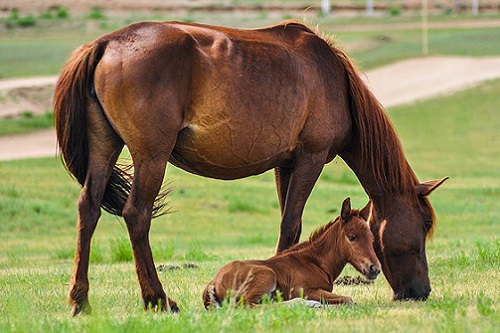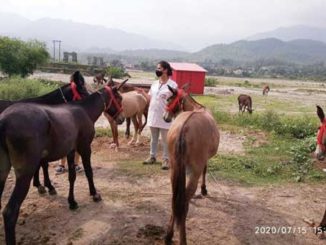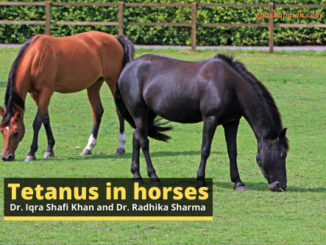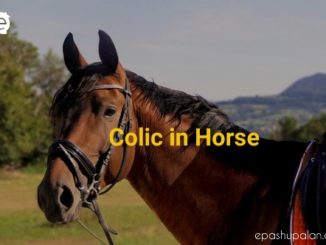Introduction
Ultimately the aim of breeding is to produce an adult horse of good genetic characteristics. Even before a live foal is born the nutrition of the mare through pregnancy, the management of the foal from day one, through weaning and continuing through the first years of life is vital to ensure survivability and build up its endurance. The breeding, and “nurturing”, both have a role in producing the best adult specimen.
The Umbilical Cord
Normally, the umbilical cord breaks when the mare or foal gets up and moves around. If not, do not cut it. As approximately 25 percent of the foal’s normal blood volume may still be circulating through the placenta at the time of delivery, the cord should be left intact long enough to allow the passage of this blood into the foal. Cutting the cord causes it to bleed more. Septicaemia, a common foal disease, is caused by bacterial invasion though the navel stump. The stump should be treated with chlorhexidine mixed one part with four parts water. The foal should be dried thoroughly. Atetanus antitoxin injection should be given to foal if the mare was not immunized before foaling. The foal must start nursing within two to three hours after birth to obtain adequate colostrum. The large immunoglobulin molecules in colostrum, which provide antibody protection, can only be absorbed in the first 12 hours after birth.

Colostrum
Colostrum, or “first milk,” has many properties which are very beneficial to newborn foal. It is high in nutrient content, has laxative properties and most importantly, is very high in antibodies and other factors important for developing the foal’s immunity. The foal is born deficient in antibodies and lacks adequate immunity. Therefore, the newborn foal is relatively incapable of fighting off disease before it obtains colostrum . The foal which has received and absorbed adequate amounts of colostrum is more capable of fighting off disease because of this colostral “passive immunity.” It protects the foal until it is able to produce its own “active immunity,” or the production of antibodies within its own body.
The First Day
Wheat straw is the preferred bedding for foaling. It does not stick to the foal or the placenta. Normally, the placenta is shed within three hours after birth. Do not pull on the un-expelled placenta.
Ammonia in Stalls
Before the age of one year, about 15% of all foals have a severe respiratory illness. High levels of ammonia have been linked to respiratory issues in foals. Protein is broken down into urea, which is expelled in the urine and released into theenvironment as ammonia. Reducing ammonia levels in stalls is one approach to prevent respiratory irritants to foals. This problem is exacerbated by the infrequent removal and replacement of filthy bedding. Ammonia odour is common in confined, hot barns. A lot of the ammonia in a stall comes from the floor, which is where newborn foals spend a lot of their time. Because young foals’ respiratory systems are undeveloped, they are more vulnerable. Sprinkling 1-2 pounds of hydrated lime after cleaning and before re-bedding, on the stall floor lower the ammonia levels. Broodmares should not be fed an excessive amount of protein. It should be sufficient to provide 14-16 percent grain with grass hay and 12 percent grain with alfalfa hay.
Handling Foals
Before they have to be handled, foals should be acclimated to being handled. Some foals will be injured, and they will need to be handled carefully so that they can be vaccinated and dewormed. When foals are young, owners should handle them and halter train them. It will be less distressing if they are accustomed to being handled, haltered, and led from an early age. Early foal training can be advantageous. Place the mother and foal in a box stall when the foal is young. When the foal’s tail is slightly curved over its croup, it normally stands peacefully.
Disease Control
To safeguard the foal as it matures, it will require a series of vaccinations. Because colostral antibodies may interfere with the foal’s ability to build long-lasting immunity, vaccines are normally given when antibodies derived from colostrumhave reduced. At three months of age, foals should begin their vaccination routine. One month later, booster shots are required to provide enough immunity. Tetanus, Eastern and Western encephalomyelitis (EEE, WEE), equine influenza, and rhinopneumonitis should all be routinely vaccinated in foals. Under some circumstances, vaccination against strangles, Potomac Horse Fever, rabies, and other diseases may be necessary.

The following is a vaccination schedule for foals
Birth
If the mare was vaccinated one month prior to foaling and the foal received adequate colostrum, no vaccination is required. If not, tetanus antitoxin should be given at birth.
Third Month
Tetanus, EEE and WEE, Influenza and Rhinopneumonitis
Fourth Month
Tetanus, EEE and WEE, Influenza and Rhinopneumonitis.Yearly boosters for all of the above vaccines are required. However, horses receiving the influenza and rhinopneumonitis (respiratory form) vaccine should be revaccinated every 60-90 days. Immunity to these diseases is short and revaccination is necessary.
Internal Parasite Control
In addition to prevention and control measures, routine deworming is a vital aspect of a foal’s health programme. Medications for controlling worms and disrupting their life cycles can be given directly into the stomach via a stomach tube, eaten in conjunction with rations, or applied as a paste inside the mouth. Paste dewormers are a good alternative for controlling worms in horses due to their availability and cost efficiency. Furthermore, putting a paste dewormer in a foal’s mouth rather than introducing a stomach tube is often safer and less distressing. Deworming of the foals should be done on a monthly basis until they reach the age of one year.
Nutritional Management
Creep feeding is a crucial part of early foal management. As foals get older, they become more reliant on solid food, while milk consumption decreases. The mare’s milk only provides about half of the protein and calories needed by the 3-month-old foal. For optimal foal growth, creep feed must be provided to match the foal’s nutrient requirements. Creep feed can be given to foals as early as two weeks of age. However, there will be virtually little consumption at this period. Foals will initially nibble and play with the creep feed before increasing their consumption to one to three pounds per day, depending on their age. Fresh creep feed should be put into the feeder daily. Creep feed left in the feeder can be fed to mares or other horses if it has not become sour or mouldy. The major considerations of a good creep feed include high quality protein, moderately high energy levels and adequate calcium and phosphorus amounts in the proper ratios.
Conclusion
To deal with existence surrounded by possible predators, the equine species has developed to develop swiftly during this early age and to show few apparent signs of sickness. This necessitates close observation of foals for the first 24 hours of their lives, as well as prompts veterinarian intervention if there are any concerns.
| The content of the articles are accurate and true to the best of the author’s knowledge. It is not meant to substitute for diagnosis, prognosis, treatment, prescription, or formal and individualized advice from a veterinary medical professional. Animals exhibiting signs and symptoms of distress should be seen by a veterinarian immediately. |






Be the first to comment